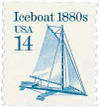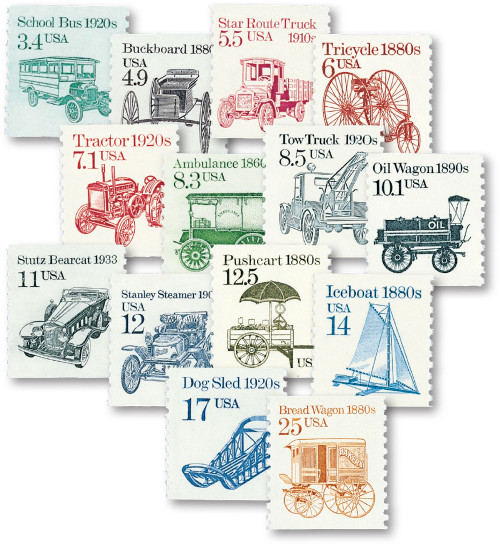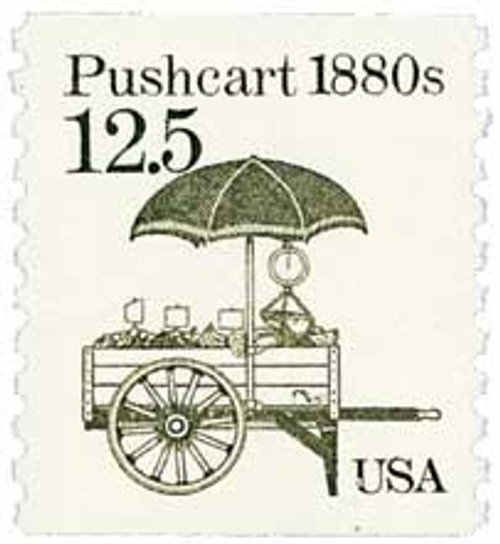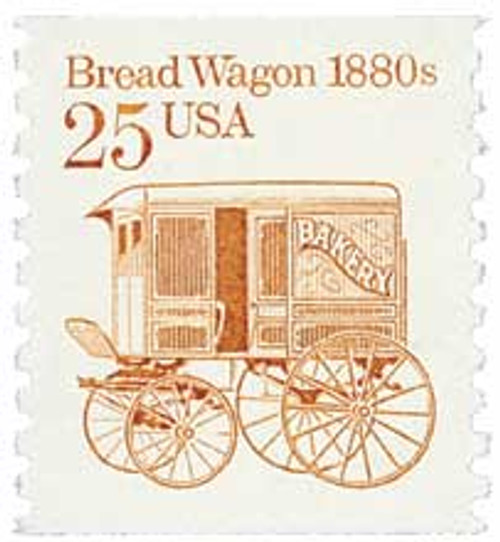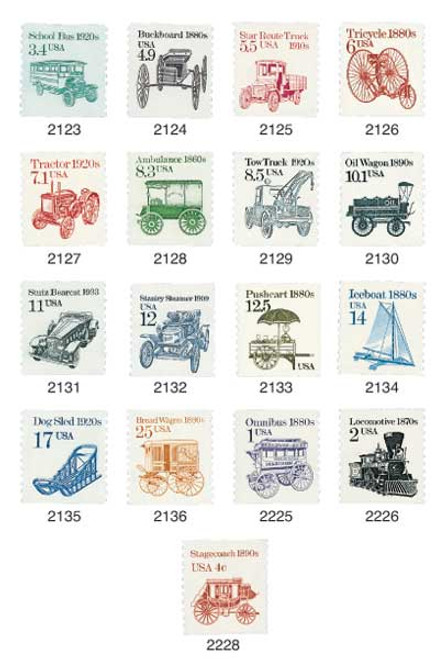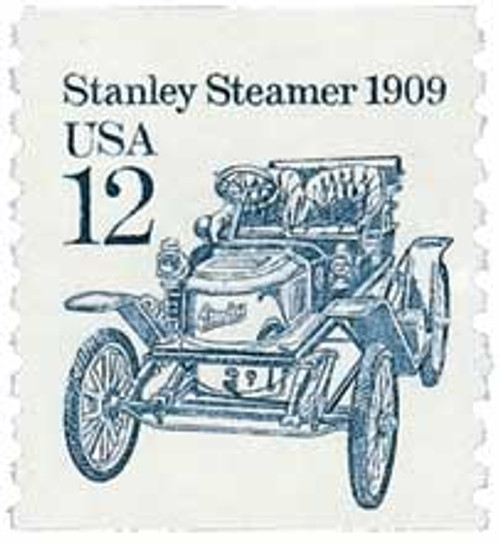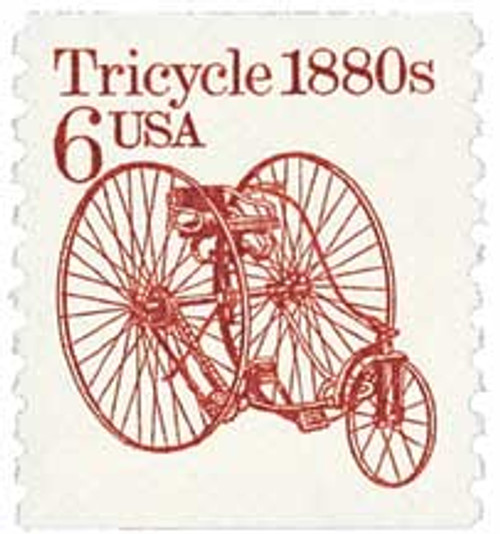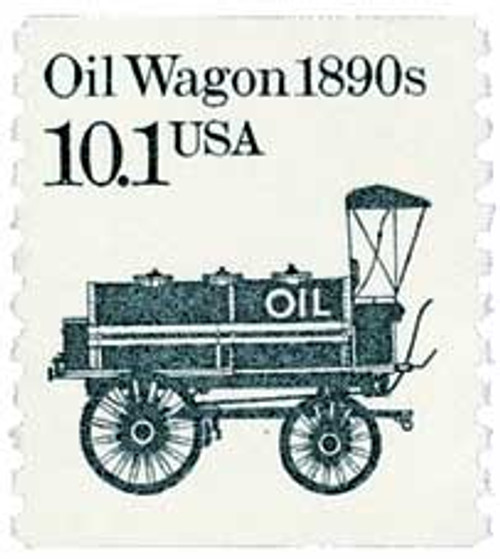
# 2134 - 1985 14c Transportation Series: Iceboat, 1880s
U.S. #2134
1985 14¢ Iceboat, 1880s
Transportation Series
- Paid the postcard rate
- 15th stamp in Transportation Series
Stamp Category: Definitive
Series: Transportation
Value: 14¢; the postcard rate
First Day of Issue: March 23, 1985
First Day City: Rochester, New York
Quantity Issued: 237,041,000
Printed by: Bureau of Engraving and Printing
Printing Method: Engraved
Format: Coils of 300 and 3,000
Perforations: 10 vertical
Color: Sky blue
Why the stamp was issued: This stamp paid the postcard rate. A Sinclair Lewis stamp had been issued two days earlier at the same rate, but the Iceboat stamp was a coil, which mass mailers used in their stamp-affixing machines.
About the stamp design: In researching this stamp, artist William Bond found that most iceboats were homemade and there were no formal blueprints or designs to work from. So he studied as many old photos as he could and built a small model of an iceboat. That model served as the inspiration for this stamp’s illustration.
About the printing process: This stamp was printed on one of the older Cottrell presses. Plate numbers were printed on every 24th stamp and joint lines (where two plates meet, a small gap allows ink through) appeared in the perforations.
First Day City: The First Day ceremony for this stamp was held at the Downtown Holiday Inn, in Rochester, New York at the ROPEX stamp exhibition.
About the Transportation Series: On May 18, 1981, the USPS issued the first stamp in the Transportation Series, US #1907, picturing the Surrey, a doorless four-wheeled carriage. For the first time in US history, a coil stamp featured its own unique design rather than simply copying that of the current definitive stamp. Over 50 more coil stamps would be issued over the course of the next 15 years, each picturing a different mode of transportation. All of these types of transportation were used since American independence.
The various denominations provided face values to exactly match the rates for several categories of Third-Class mail (bulk rate and quantity-discounted mail). As the rates changed, new stamps with new values were added. Never before had a stamp series included so many fractional cent values.
The Bureau of Engraving and Printing printed most of the stamps in the Transportation Series, although private contractors printed a few. All but a few of the later stamps were produced by engraved intaglio. Differences in precancels, tagging, paper and gum provide a large number of varieties.
Scott Catalog separates the Transportation stamps into four groups. The stamps in the first group (#1897-1908) generally have the denomination in small type with a “c” next to it. These stamps were printed on the Cottrell rotary press, which joined together two plates to make a sleeve. The gaps between these plates created depressions where ink would collect and create joint lines on the stamps. Later issues were printed on a different press and didn’t have these joint lines.
The second group (#2123-36) had larger numbers with no “c.” The third group (#2252-66) was similar in appearance to the second group, but service inscriptions were added to the designs. These stamps also used a variety of paper and gum as well as different types of tagging. The fourth group (#2451-68) marked the end of fractional values. Now bulk mailers would use either the 5¢ or 10¢ stamp and then pay the difference from the actual postage rate.
The last stamp in the Transportation Series, the 20¢ Cog Railway, was issued on June 9, 1995, at the TEXPEX ’95 stamp show in Dallas, Texas. This marked the end of the largest US definitive series up to that time and the largest US coil stamp series in history. Three new series would eventually replace it – American Transportation, American Culture, and American Scenes. Additionally, the Great Americans would go on to become the largest American definitive series.
History the stamp represents: Invented by the Dutch in the 1790s, the iceboat was the main mode of transportation on the Netherlands’ canals in the winter. Dutch settlers introduced the boats to the U.S., and in the early 19th century, they were often raced on the Hudson River in New York State. The design was a narrow hull with a crosspiece attached to runners at either end, and a single mast supporting two sails. One of the largest iceboats ever built was the Icicle, which occasionally raced trains that ran on the tracks next to the Hudson River.
U.S. #2134
1985 14¢ Iceboat, 1880s
Transportation Series
- Paid the postcard rate
- 15th stamp in Transportation Series
Stamp Category: Definitive
Series: Transportation
Value: 14¢; the postcard rate
First Day of Issue: March 23, 1985
First Day City: Rochester, New York
Quantity Issued: 237,041,000
Printed by: Bureau of Engraving and Printing
Printing Method: Engraved
Format: Coils of 300 and 3,000
Perforations: 10 vertical
Color: Sky blue
Why the stamp was issued: This stamp paid the postcard rate. A Sinclair Lewis stamp had been issued two days earlier at the same rate, but the Iceboat stamp was a coil, which mass mailers used in their stamp-affixing machines.
About the stamp design: In researching this stamp, artist William Bond found that most iceboats were homemade and there were no formal blueprints or designs to work from. So he studied as many old photos as he could and built a small model of an iceboat. That model served as the inspiration for this stamp’s illustration.
About the printing process: This stamp was printed on one of the older Cottrell presses. Plate numbers were printed on every 24th stamp and joint lines (where two plates meet, a small gap allows ink through) appeared in the perforations.
First Day City: The First Day ceremony for this stamp was held at the Downtown Holiday Inn, in Rochester, New York at the ROPEX stamp exhibition.
About the Transportation Series: On May 18, 1981, the USPS issued the first stamp in the Transportation Series, US #1907, picturing the Surrey, a doorless four-wheeled carriage. For the first time in US history, a coil stamp featured its own unique design rather than simply copying that of the current definitive stamp. Over 50 more coil stamps would be issued over the course of the next 15 years, each picturing a different mode of transportation. All of these types of transportation were used since American independence.
The various denominations provided face values to exactly match the rates for several categories of Third-Class mail (bulk rate and quantity-discounted mail). As the rates changed, new stamps with new values were added. Never before had a stamp series included so many fractional cent values.
The Bureau of Engraving and Printing printed most of the stamps in the Transportation Series, although private contractors printed a few. All but a few of the later stamps were produced by engraved intaglio. Differences in precancels, tagging, paper and gum provide a large number of varieties.
Scott Catalog separates the Transportation stamps into four groups. The stamps in the first group (#1897-1908) generally have the denomination in small type with a “c” next to it. These stamps were printed on the Cottrell rotary press, which joined together two plates to make a sleeve. The gaps between these plates created depressions where ink would collect and create joint lines on the stamps. Later issues were printed on a different press and didn’t have these joint lines.
The second group (#2123-36) had larger numbers with no “c.” The third group (#2252-66) was similar in appearance to the second group, but service inscriptions were added to the designs. These stamps also used a variety of paper and gum as well as different types of tagging. The fourth group (#2451-68) marked the end of fractional values. Now bulk mailers would use either the 5¢ or 10¢ stamp and then pay the difference from the actual postage rate.
The last stamp in the Transportation Series, the 20¢ Cog Railway, was issued on June 9, 1995, at the TEXPEX ’95 stamp show in Dallas, Texas. This marked the end of the largest US definitive series up to that time and the largest US coil stamp series in history. Three new series would eventually replace it – American Transportation, American Culture, and American Scenes. Additionally, the Great Americans would go on to become the largest American definitive series.
History the stamp represents: Invented by the Dutch in the 1790s, the iceboat was the main mode of transportation on the Netherlands’ canals in the winter. Dutch settlers introduced the boats to the U.S., and in the early 19th century, they were often raced on the Hudson River in New York State. The design was a narrow hull with a crosspiece attached to runners at either end, and a single mast supporting two sails. One of the largest iceboats ever built was the Icicle, which occasionally raced trains that ran on the tracks next to the Hudson River.






